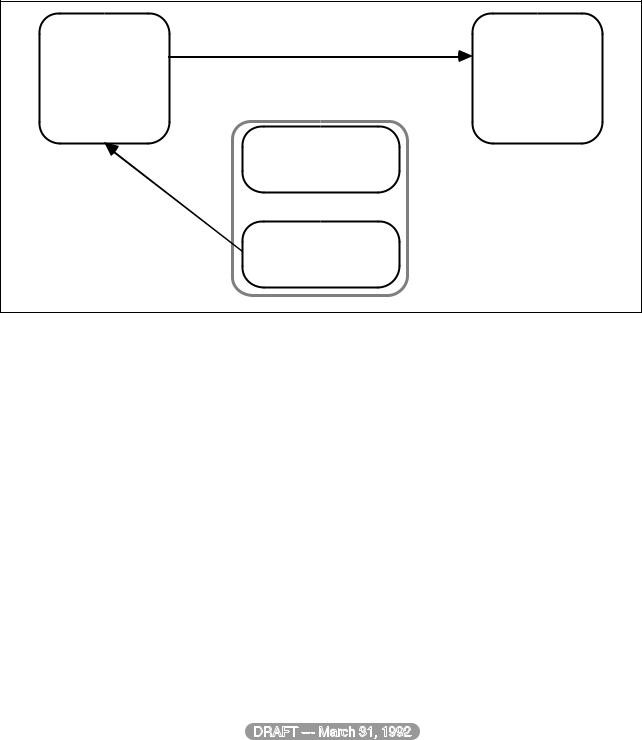
Barrett G.Occam 3 reference manual.1992
.pdf
The appendices
A |
Configuration |
Describes how to allocate processes to individual processors, how to |
|
|
give priority to processes running on a single processor, and place |
B |
|
elements at absolute locations in memory. |
Ports |
Describes how to communicate with memory mapped devices. |
|
C |
Mapping types |
Describes how to convert the data type of a bit pattern. |
D |
Concrete |
Describes how to control the physical layout of data in memory. |
|
representation of data |
|
E |
types |
|
Rounding errors |
Describes the rounding modes of the ANSI/IEEE standard. |
|
F |
Omitting type |
Describes when type decorations can be omitted from literals. |
|
decorations from |
|
G |
literals |
|
Anarchic protocol |
Describes the unstructured protocol ANY. |
|
H |
Usage rules check list |
A check list of the rules which apply to names used in parallel processes |
I |
|
and abbreviations. |
Invalid processes |
Describes the three modes of existence for invalid processes. |
|
J |
Syntax summary |
A complete list of the occam syntax. Each syntactic object is pre- |
|
|
sented in context, and also alphabetically. |
K |
Keywords and symbols |
A complete list of the keywords and symbols used in occam. |
L |
Character set |
The occam character set, ASCII table. |
M |
Standard libraries |
A complete list of all the procedures and functions in standard libraries. |
N |
Multiple length |
Describes the routines available for multiple length arithmetic. |
O |
arithmetic functions |
|
Floating point functions |
Describes the routines available for floating point operations. |
|
P |
IEEE floating point |
Describes the routines available for floating point operations. |
Q |
arithmetic |
|
Elementary function |
Describes the routines in the elementary function library. |
|
R |
library |
|
Value, string |
Describes the routines to convert between values and strings. |
|
S |
conversion routines |
|
Glossary |
A complete glossary of terms. |
|
|
THE INDEX |
A comprehensive index |
|
|
|
DRAFT --- March 31, 1992

The occam programming language is designed to express concurrent algorithms and their implementation on a network of processing components.
The occam reference manual serves to provide a single reference, and definition of the language occam. The manual describes each aspect of the language, starting with the most primitive components of an occam program, and moving on to cover the whole language in detail. The manual is addressed to the wider audience, including not only the computer scientist, software engineer and programmer, but also the electronics engineer and system designer.
Programming in occam is easy. occam enables an application to be described as a collection of processes, where each process executes concurrently, and communicates with other processes through channels. Each process in such an application describes the behaviour of a particular aspect of the implementation, and each channel describes the connection between each of the processes. This approach has two important consequences. Firstly, it gives the program a clearly defined and simple structure. Secondly, it allows the application to exploit the performance of a system which consists of many parts.
Concurrency and communication are the prime concepts of the occam model. occam captures the hierarchical structure of a system by allowing an interconnected set of processes to be regarded as a unified, single process. At any level of detail, the programmer is only concerned with a small, manageable set of processes.
occam is an ideal introduction to a number of key methodologies in modern computer science. occam programs can provide a degree of security unknown in conventional programming languages such as C, FORTRAN or Pascal. occam simplifies the task of program verification, by allowing application of mathe-
matical proof techniques to prove the correctness of programs. Transformations, which convert a process from one form to a directly equivalent form, can be applied to the source of an occam program to improve its
efficiency in any particular environment. occam makes an ideal language for specification and behavioural description. occam programs are easily configured onto the hardware of a system or indeed, may specify the hardware of a system.
The founding principle of occam is a minimalist approach which avoids unnecessary duplication of language mechanism, and is named after the 14th century philosopher William of Occam who proposed that invented entities should not be duplicated beyond necessity. This proposition has become known as “Occam's razor”.
The occam programming language arises from the concepts founded by David May in EPL (Experimental Programming Language) and Tony Hoare in CSP (Communicating Sequential Processes). Since its conception in 1982 occam has been, and continues to be under development at INMOS Limited, in the United Kingdom, under the direction of David May. The support for large programs provided by occam3 is based on principles found in many current programming languages which have been refined at INMOS by Geoff Barrett. The development of the INMOS transputer, a device which places a microcomputer on a single chip, has been closely related to occam, its design and implementation. The transputer reflects the occam architectural model, and may be considered an occam machine. occam is the language of the transputer and as such, when used to program a single transputer or a network of transputers, provides the equivalent efficiency to programming a conventional computer at assembler level. However, this manual does not make any assumptions about the hardware implementation of the language or the target system.
occam is a trademark of the INMOS group of companies.
DRAFT --- March 31, 1992

DRAFT --- March 31, 1992

This manual describes the programming language occam3. occam3 is an extension of occam2 with new constructs to support medium and large programs. In particular, occam3 has mechanisms for the definition of new data types, and for the construction of modules and libraries. The extensions also include constructs which allow an efficient implementation of shared channels.
This manual was completed during 1991 and 1992 as a part of the final development of occam3 at the INMOS Microcomputer Centre, Bristol, UK.
Using this manual
This book is designed primarily to be used as a reference text for the programming language occam. However, the manual should also serve as an introduction to the language for someone with a reasonable understanding of programming languages. The primitive aspects of the language are presented at the start of the manual, with as few forward references as possible. It is therefore possible to read the manual from cover to cover, giving the reader an insight into the language as a whole. The manual is cross referenced throughout, and a full index and glossary of terms are provided at the end of the manual.
Keywords and example program fragments appear in a bold program font throughout, for example:
-- example program fragment IF
occam
programming := easy
Words which appear in italic indicate a syntactic object, but may also serve to emphasise a need to cross reference and encourage referral to the index. Mathematical symbols and names referring to a mathematical values use a .
Figures are used in a number of places to illustrate examples, they use the following conventions: an arrowed line represents a channel, a round cornered box represents a process (referred to here as a process box), a lighter coloured process box combines a number of smaller processes. The conventions are illustrated in figure 0.1.
DRAFT --- March 31, 1992

a process |
a process |
a channel
combined processes
Figure 0.1 Figure conventions
DRAFT --- March 31, 1992

Syntactic notation
The syntax of occam programs is described in a modified Backus-Naur Form (BNF). As an example, the following shows the syntax of assignment, discussed on page 5:
assignment |
variable := expression |
|
|
This means “An assignment is a variable followed by the symbol :=, followed by an expression”. A vertical bar (|) means “or”, so for example:
action |
| |
assignment |
|
|
input |
||
|
| |
output |
|
is the same as |
|
|
|
action |
|
assignment |
|
action |
input |
||
|
|||
action |
output |
||
|
|||
|
|
The meaning of this syntax is “An action is an assignment, an input, or an output”.
The written structure of occam programs is specified by the syntax. Each statement in an occam program normally occupies a single line, and the indentation of each statement forms an intrinsic part of the syntax of the language. The following example shows the syntax for sequence discussed on page 9:
sequence |
SEQ |
|
|
|
process |
|
|
|
The syntax here means “A sequence is the keyword SEQ followed by zero or more processes, each on a separate line, and indented two spaces beyond SEQ”. Curly brackets and are used to indicate the number of times some syntactic object occurs. process means, “zero or more processes, each on a separate
line”. Similarly, |
0 , expression , means “A list of zero or more expressions, separated by commas”, and |
1 , expression |
, means “A list of one or more expressions, separated by commas”. |
A complete summary of the syntax of the language is given at the end of the main body of the manual (starting on page 119).
Continuation lines
A long statement may be broken immediately after one of the following:
an operator |
i.e. +, -, *, / etc.. |
|
a comma |
, |
|
a semi-colon |
; |
|
assignment |
:= |
|
the keyword |
IS, FROM or FOR |
|
|
|
|
|
|
A statement can be broken over several lines providing the continuation is indented at least as much as the first line of the statement.
The annotation of occam programs
As the format of occam programs is significant, there are a number of rules concerning how programs are annotated. A comment is introduced by a double dash symbol (--), and extends to the end of the line.
DRAFT --- March 31, 1992

Consider the following sequence:
SEQ
--This example illustrates the use of comments
--A comment may not be indented less than
-- |
the following |
statement |
... |
|
|
SEQ |
-- A sequence |
|
... |
|
|
Comments may not be indented less than the following statement.
Names and keywords used in occam programs
Names used in occam programs must begin with an alphabetic character. Names consist of a sequence of alphanumeric characters and dots. There is no length restriction. occam is sensitive to the case of names, i.e. Say is considered different from say. With the exception of the names of channel protocols, names
in the examples presented in this manual are all lower case. However, the following are all valid names in occam:
PACKETS vector6 LinkOut NOT.A.NUMBER transputer terminal.in terminalOut
All keywords are upper case (e.g. SEQ). All keywords are reserved, and thus may not be used by the programmer. A full list of the keywords appear on page 144. The names of library routines are given in the appendix starting on page 148.
DRAFT --- March 31, 1992

1.1Assignment
occam programs are built from processes. The simplest process in an occam program is an action. An action is either an assignment, an input or an output. Consider the following example:
x := y + 2
This simple example is an assignment, which assigns the value of the expression y + 2 to the variable x. The syntax of an assignment is:
assignment |
variable := expression |
|
|
The variable on the left of the assignment symbol (:=) is assigned the value of the expression on the right of the symbol. The value of the expression must be of the same data type as the variable to which it is to be assigned, otherwise the assignment is not valid.
Variables are discussed on page 29, data types are discussed on page 23, and expressions on page 67.
A multiple assignment assigns values to several variables, as illustrated in the following example:
a, b, c := x, y + 1, z + 2
This assignment assigns the values of x, y + 1 and z + 2 to the variables a, b and c respectively. The expressions on the right of the assignment are evaluated, and the assignments are then performed in parallel. Consider the following example:
x, y := y, x
The effect of this multiple assignment is to swap the values of the variables x and y.
The syntax of multiple assignment extends the syntax for assignment:
assignment |
variable.list := expression.list |
|
variable.list |
|
1 , variable |
|
||
|
|
|
expression.list |
|
1 , expression |
|
|
|
A list of expressions appearing to the right of the assignment symbol (:=) is evaluated in parallel, and then each value is assigned (in parallel) to the corresponding variable of the list to the left of the symbol. The rules which govern the names used in a multiple assignment therefore follow from those for names used in parallel constructions (see page 16). Practically, this means that no name may appear twice on the left side of a multiple assignment, as the name of a variable or as the name of a variable and the name of a subscript expression which selects a component from an array (data type arrays are explained in section 3.2 which starts on page 26).
The expression on the right of the assignment symbol (:=) may be a function. A multiple result function can be an expression list in a multiple assignment. Functions are discussed in chapter 12 starting on page 81.
1.2Communication
Communication is an essential part of occam programming. Values are passed between concurrent processes by communication on channels. Each channel provides unbuffered, unidirectional point-to-point communication between two concurrent processes. The format and type of communication on a channel is
DRAFT --- March 31, 1992

specified by a channel protocol given in the declaration of a channel. Channel protocols are discussed in chapter 6, which starts on page 46, and channel declarations are discussed in the same chapter on page 45.
Two actions exist in occam which perform communication on a channel. They are: input and output.
1.2.1 Input
An input receives a value from a channel and assigns the received value to a variable. Consider the following example:
keyboard ? char
This simple example receives a value from the channel named keyboard and assigns the value to the variable char. The input waits until a value is received.
The syntax of an input is:
input |
channel ? variable |
|
|
An input receives a value from the channel on the left of the input symbol (?), and assigns that value to the variable on the right of the symbol. The value input must be of the same data type as the variable to which it is assigned, otherwise the input is not valid. Variables are discussed on page 29, and data types are discussed on page 23.
1.2.2 Output
An output transmits the value of an expression to a channel. Consider the following example:
screen ! char
This simple example transmits the value of the variable char to the channel named screen. The output waits until the value has been received by a corresponding input.
The syntax of an output is:
output |
channel ! expression |
|
|
An output transmits the value of the expression on the right of the output symbol (!) to the channel named on the left of the symbol.
Variables are discussed on page 29 and expressions on page 67.
1.3SKIP and STOP
The primitive process SKIP starts, performs no action and terminates.
The primitive process STOP starts, performs no action and never terminates.
To explain how SKIP behaves, consider the following sequence:
SEQ
keyboard ? char SKIP
screen ! char
DRAFT --- March 31, 1992

This sequence executes the input keyboard ? char, then executes SKIP, which performs no action. The sequence continues, and the output screen ! char is executed. The behaviour of STOP is illustrated by the following sequence:
SEQ
keyboard ? char STOP
screen ! char
This sequence performs the input keyboard ? char before, then executes STOP, which starts but does not terminate and so does not allow the sequence to continue. The output screen ! char is never executed.
1.4Summary
The primitive occam processes are assignments, inputs, outputs, SKIP and STOP:
process |
| |
assignment |
|
input |
|
|
| |
output |
|
| |
SKIP |
|
| |
STOP |
DRAFT --- March 31, 1992
